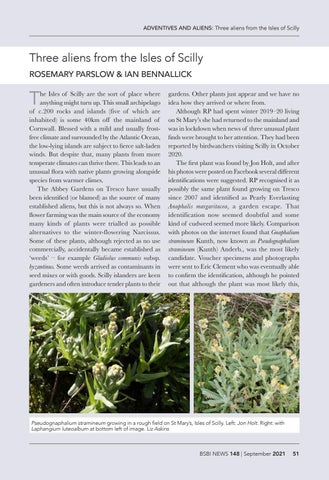ADVENTIVES AND ALIENS: Three aliens from the Isles of Scilly
Three aliens from the Isles of Scilly ROSEMARY PARSLOW & IAN BENNALLICK
T
he Isles of Scilly are the sort of place where anything might turn up. This small archipelago of c.200 rocks and islands (five of which are inhabited) is some 40km off the mainland of Cornwall. Blessed with a mild and usually frostfree climate and surrounded by the Atlantic Ocean, the low-lying islands are subject to fierce salt-laden winds. But despite that, many plants from more temperate climates can thrive there. This leads to an unusual flora with native plants growing alongside species from warmer climes. The Abbey Gardens on Tresco have usually been identified (or blamed) as the source of many established aliens, but this is not always so. When flower farming was the main source of the economy many kinds of plants were trialled as possible alternatives to the winter-flowering Narcissus. Some of these plants, although rejected as no use commercially, accidentally became established as ‘weeds’ – for example Gladiolus communis subsp. byzantinus. Some weeds arrived as contaminants in seed mixes or with goods. Scilly islanders are keen gardeners and often introduce tender plants to their
gardens. Other plants just appear and we have no idea how they arrived or where from. Although RP had spent winter 2019–20 living on St Mary’s she had returned to the mainland and was in lockdown when news of three unusual plant finds were brought to her attention. They had been reported by birdwatchers visiting Scilly in October 2020. The first plant was found by Jon Holt, and after his photos were posted on Facebook several different identifications were suggested. RP recognised it as possibly the same plant found growing on Tresco since 2007 and identified as Pearly Everlasting Anaphalis margaritacea, a garden escape. That identification now seemed doubtful and some kind of cudweed seemed more likely. Comparison with photos on the internet found that Gnaphalium stramineum Kunth, now known as Pseudognaphalium stramineum (Kunth) Anderb., was the most likely candidate. Voucher specimens and photographs were sent to Eric Clement who was eventually able to confirm the identification, although he pointed out that although the plant was most likely this,
Pseudognaphalium stramineum growing in a rough field on St Mary’s, Isles of Scilly. Left: Jon Holt. Right: with Laphangium luteoalbum at bottom left of image. Liz Askins
BSBI NEWS 148 | September 2021
51

















